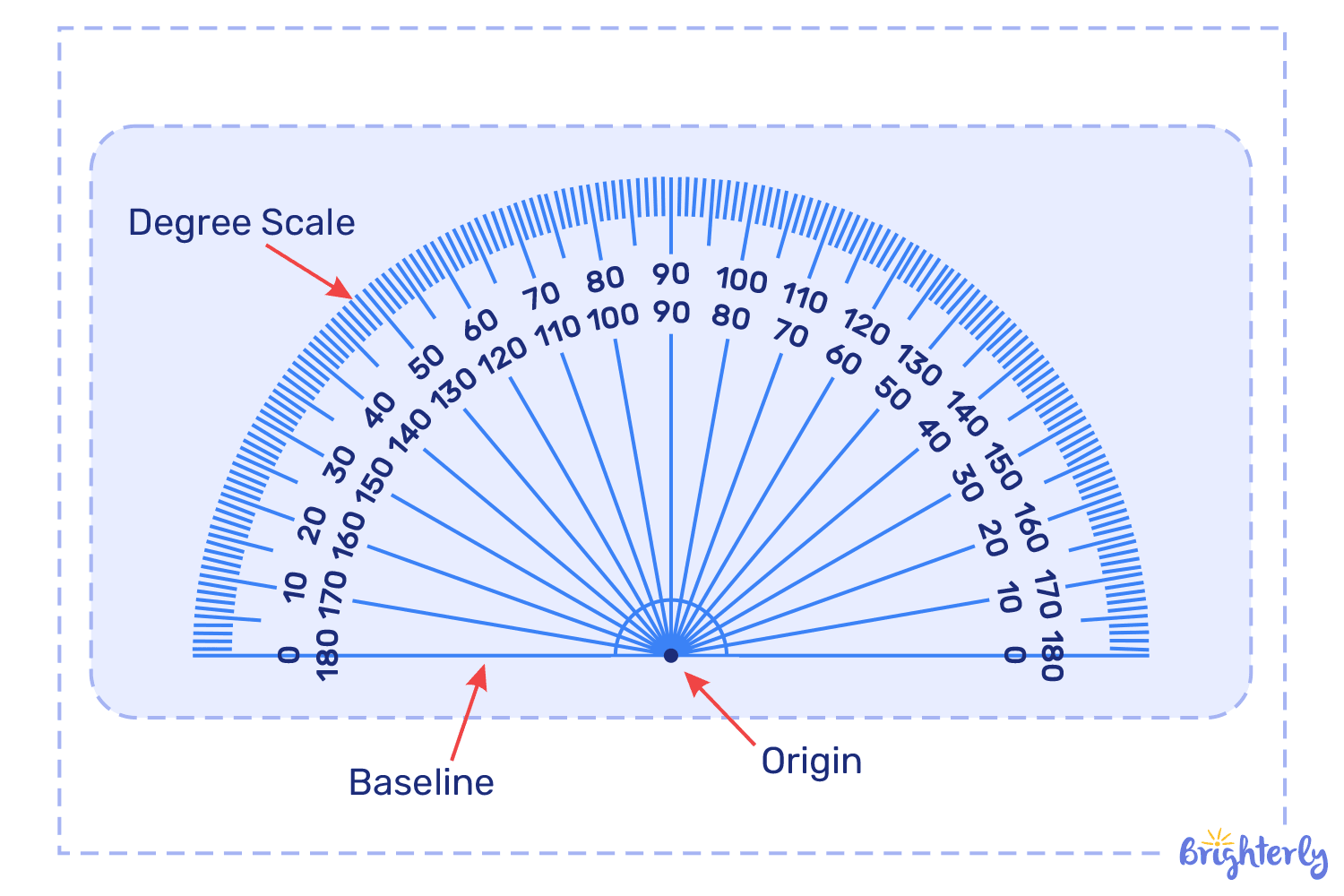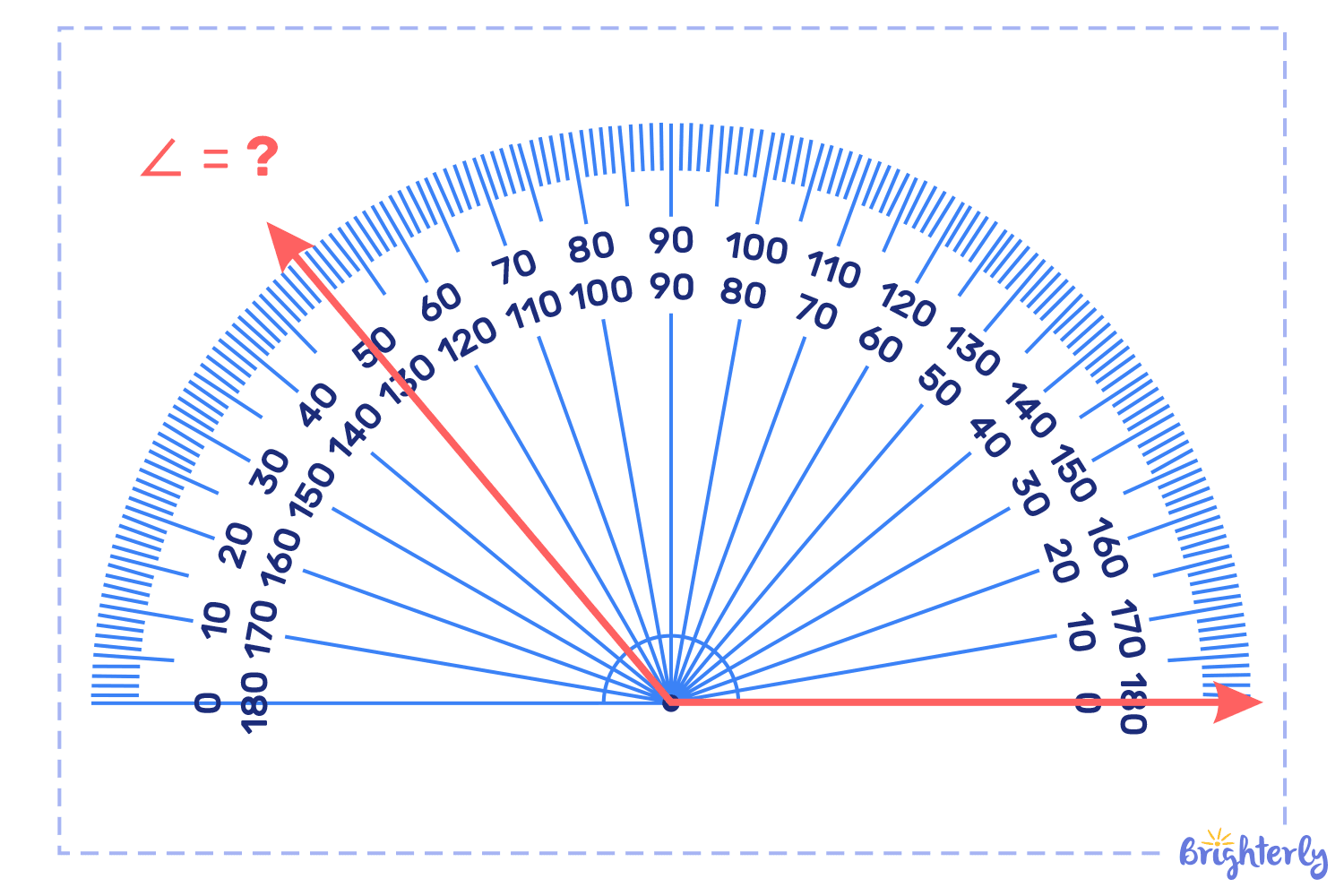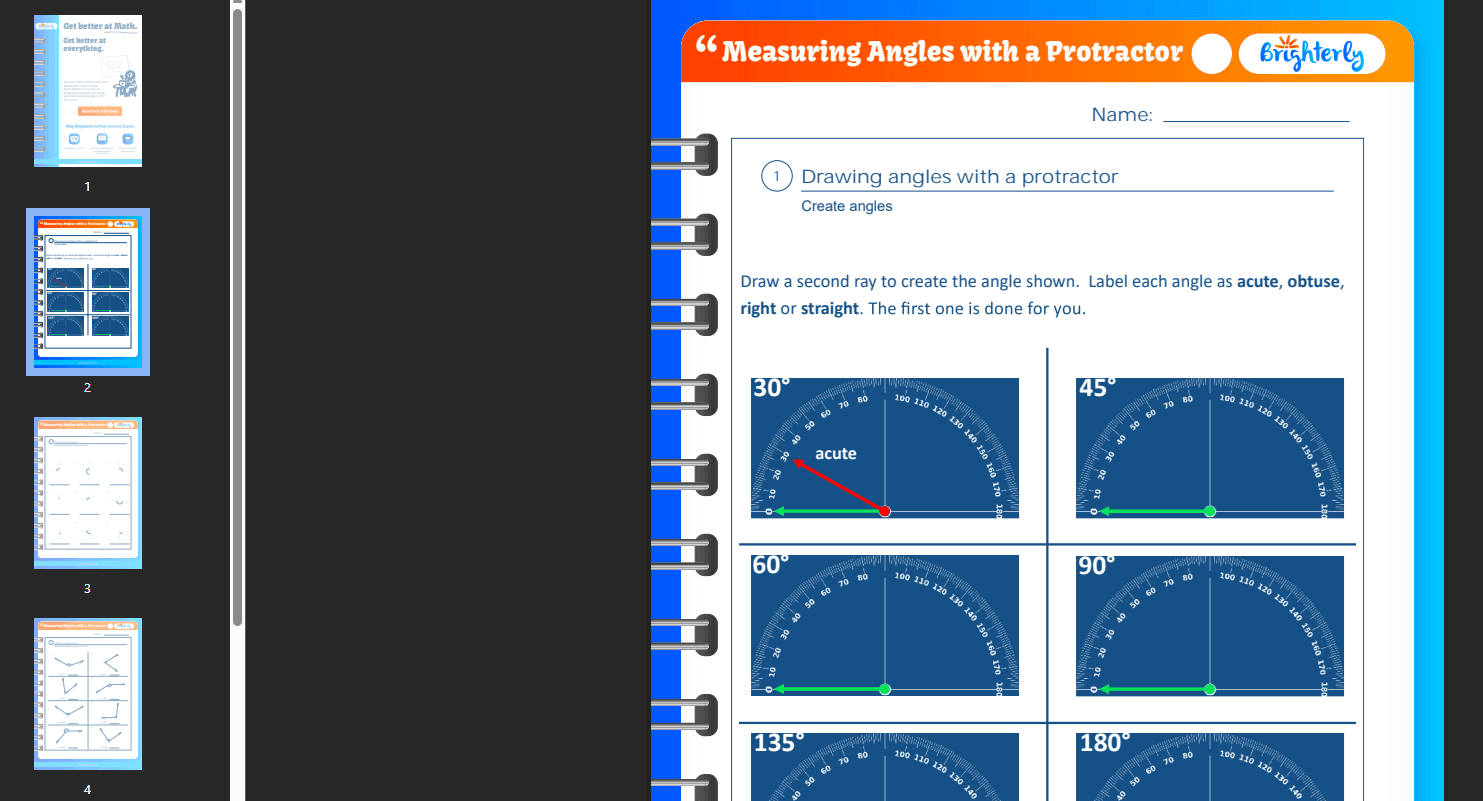How To Use a Protractor? A Step-by-Step Guide
reviewed by Jo-ann Caballes
Updated on December 21, 2025
By the 4th grade, kids begin learning types of angles. Soon enough, it’s time to use a protractor.
But many kids get confused with the instrument that just shows dashes and numbers. A protractor may be tricky at first, but it’s really just a tool to use during your geometry practice. In this article, I’ll guide you through the information on how to use a protractor, line it up, read the numbers, and make it easy.
Key points
- A protractor is a math tool used to measure and draw angles in degrees.
- Students can use it to find out angles in degrees in school, math projects, or any time they need.
- Math platforms like Brighterly use gamified techniques and 1-on-1 tutoring to teach your students to use the protractor in a fun and effective way.
What is a protractor?
A math protractor is a tool designed to measure and draw angles in degrees. It’s transparent and marked from 0° to 180° on the inner and outer corners. With the help of a protractor, students can create accurate geometric figures, understand angles in geometry, and more.
What is a protractor used for?
The use of protractor is to measure and draw angles in degrees. Kids use it to find out if an angle is small, large, or a right angle. It comes in handy in school, for math projects, or any time students need to work with angles that require precision.
Using a protractor may seem easy. However, these tools sometimes challenge even high schoolers, who regularly google “protractor tutorial for beginners”. If this is the case with your kid (no matter their age), you may want to consider finding the right tutor.
Do math platforms help kids understand how to measure angles with a protractor?
If reading a protractor is an undoable task for your kid, starting a tutoring plan can be a good idea.
Firstly, the inability to understand the protractor may stem from deeper gaps in your child’s understanding of math. A tutoring platform can correctly identify and fix those gaps. For example, the Brighterly math and reading platform features a free demo session where your child gets tested and receives personalized recommendations for improvement to close knowledge gaps and answer questions like “how to use a protractor”.
At Brighterly, kids receive help with protractors and beyond through working with trained math tutors can help catch growing knowledge gaps early and rebuild confidence in math from the ground up.
Math platforms teach kids to measure angles with a protractor by breaking this concept into smaller, simple steps. For instance, on the Brighterly math platform, lessons usually start by identifying parts of a protractor and understanding degrees.
Brighterly’s math program also involves interactive visuals and hands-on experiences to help children understand what is protractor and how to use it for their goals.
And finally, using the right math worksheets can make a big difference. These are great because they can be used both in a classroom and for your home practice. Take a look at the educational tasks included in these measuring angles with a protractor worksheet samples — they come with answer keys in PDFs, so they can be used immediately.
Now, let’s look at the protractor step by step and explore what its parts are.
Parts of a protractor
To read angles on a protractor correctly and avoid any future inconsistencies, your kid should understand all the basic parts of the tool.

Baseline
The baseline of a protractor is a horizontal line at the bottom, also called the reference point. A vertical line bisects the baseline of a protractor at its center point. Since the baseline has two sides, they are called left and right-side baselines.
Origin
The origin of a protractor is a point where the baseline and the perpendicular line meet at the bottom. A vertical line cuts the baseline precisely in the middle, through the origin. This place is also called the center or midpoint. When you teach how to use a protractor for kids, the origin is where you should start your explanation.
Degree scale
When your child first handles a protractor, they may notice long and short lines.
- Each short line inside a semicircle represents a degree, and the total number of degrees is one hundred and eighty (180). There are tiny line segments for every one degree (1), with extra line segments for every five (5) and ten degrees (10) in between.
- An inner degree scale shows the numbers from 0 to 180 rotating anticlockwise from the right side of the protractor. The outer degree scale shows the numbers rotating clockwise from the left side of the semicircular degree scale.
With an understanding of these crucial parts, your child will quickly grasp how to measure angles with a protractor.
How to read a protractor?
To read a protractor, you have to go through these 3 easy steps:
- Align the angle’s vertex with the dot at the protractor’s center.
- Place one side of the angle along the 0-degree line on the protractor.
- Check where the other side of the angle intersects the number scale on a protractor.
How to use a protractor to measure angles?
To learn how to use protractor to measure angles, your child should align the origin with the angle’s vertex, line up the angle’s side with 0 degrees on the protractor, and interpret where the other side of the angle crosses the degree scale.
However, note that the scale has two sides. Kids should be careful with that and learn to use the same number scale for both sides of the angle.
How do you read a protractor? Let’s practice!

In the example above, one side of an angle crosses the 0-degree point at the inner scale.
Thus, your kid should also read the inner scale to define the angle.
And here’s to the essence: how to find the measure of an angle? The angle’s side crosses the scale at 130 degrees, which is actually the measurement we needed.
Teaching how to use a protractor for kids
How to use a protractor to draw angles involves several steps:
- First, explain to your child what those numbers mean and remind them to read the correct scale (inner/outer).
- Help the kid find the origin and place it at the vertex of the angle you’re about to measure.
- Tell them to align one angle’s leg with the baseline.
- Then, follow the leg of the opposite angle up to the measuring scale. Double-check that your kid refers to the correct scale.
- To practice, the child can also use the protractor to determine each angle of a given triangle.
- And finally, math tests are a wonderful way to check how well your kid understands the use of protractor!
Now, once kids know what is the easiest way to measure angles, they face another challenge — the need to interpret the results. It is just a little reminder that there are three common types of angles:
- Acute — those that are less than 90 degrees;
- Obtuse — if they are above 90 degrees;
- Right — that is precisely 90 degrees.
And for practice, try to define which type of angle this is:
But is what we’ve discussed the only way to measure angles with a protractor?
Not really! You do not need to panic if you don’t have a protractor at home. Here are a few life hacks for replacing the instrument with improvised means.
Print a protractor
You can practice measuring angles with a protractor in its printable version. Just download the protractor in PDF format. This improvised tool is handy because it lets you make many copies. So, if your child damages anything, you can get them a new one.
However, note that experts don’t recommend using this alternative regularly. The thing is that the measurements may be off. Sometimes, you may end up with degree scales that are either less or more than those on a standard protractor.
Using a clock face
If you are wondering how to find the measure of an angle with a clock, it’s easier than you might think. First, help your kid picture the angle, like the clock hand moving from 12 to 6. That’s how it works: every hour marked on the clock represents 30 degrees.
Likewise, if the clock hands show 3 and 6, then there are three marks on the clock face, making a 90-degree angle (3 hours multiplied by 30 degrees). This technique helps estimate angles that match the well-known segments of a clock.
Paper folding
Paper folding is a great way to show how to use a protractor for kids. For this method, your kid just needs a piece of paper. First, help them fold the paper along one side of the angle to align the edge with the other side. After folding, examine the angle formed by the crease.
This technique is excellent for defining right angles. But it’s also limited to this angle type only.
Compass and ruler
It is the most complex and accurate method. Your child needs a compass and a ruler.
- First, ask them to draw a line or a part of the angle with the ruler.
- Tell them to place the compass on one endpoint of the line and draw an arc. Then, move the compass to the other endpoint and draw another drawing arc.
- The intersection of these two arcs will be the angle’s vertex.
- Help them use the ruler to measure the angle between the two rays.
This method uses the principles of circles and radii and so measures angles accurately.
What are common protractor mistakes?
When kids learn how do you use a protractor, they often make some common mistakes. One of the most common things is when children rush and don’t align the tool up correctly.
Another error commonly occurs when reading the wrong scales. Most protractors have 2 number scales, so it’s easy for kids to start from the wrong side. How to avoid that? Get your child to always check which side begins with zero on their angle.
Another common mistake is misaligning the vertex. This teeny-tiny hole or center mark got to sit exactly on the angle’s corner. I’ve seen kids set ot off by even a little, so they always got the measurement wrong. This is when most students start to google “How do I know which number to use on a protractor?”.
Misreading obtuse angles is another common theme. Children tend to stop at 60 or 120 degrees. Here’s a top: if the angle is wider than a right angle, the answer should be more than 90 degrees.
Conclusion
A protractor is the math instrument children tame during their early school years. But they also use it extensively in middle and high school. That’s why learning to work with it correctly is so important. In fact, with a bit of extra clarification and guidance, measuring angles with a protractor is not that difficult.
So, if you need help with the tool or other math topic, why not book free math lesson with Brighterly? Caring and professional, tutors here will help your kid understand what they study, not just blindly memorize.

















